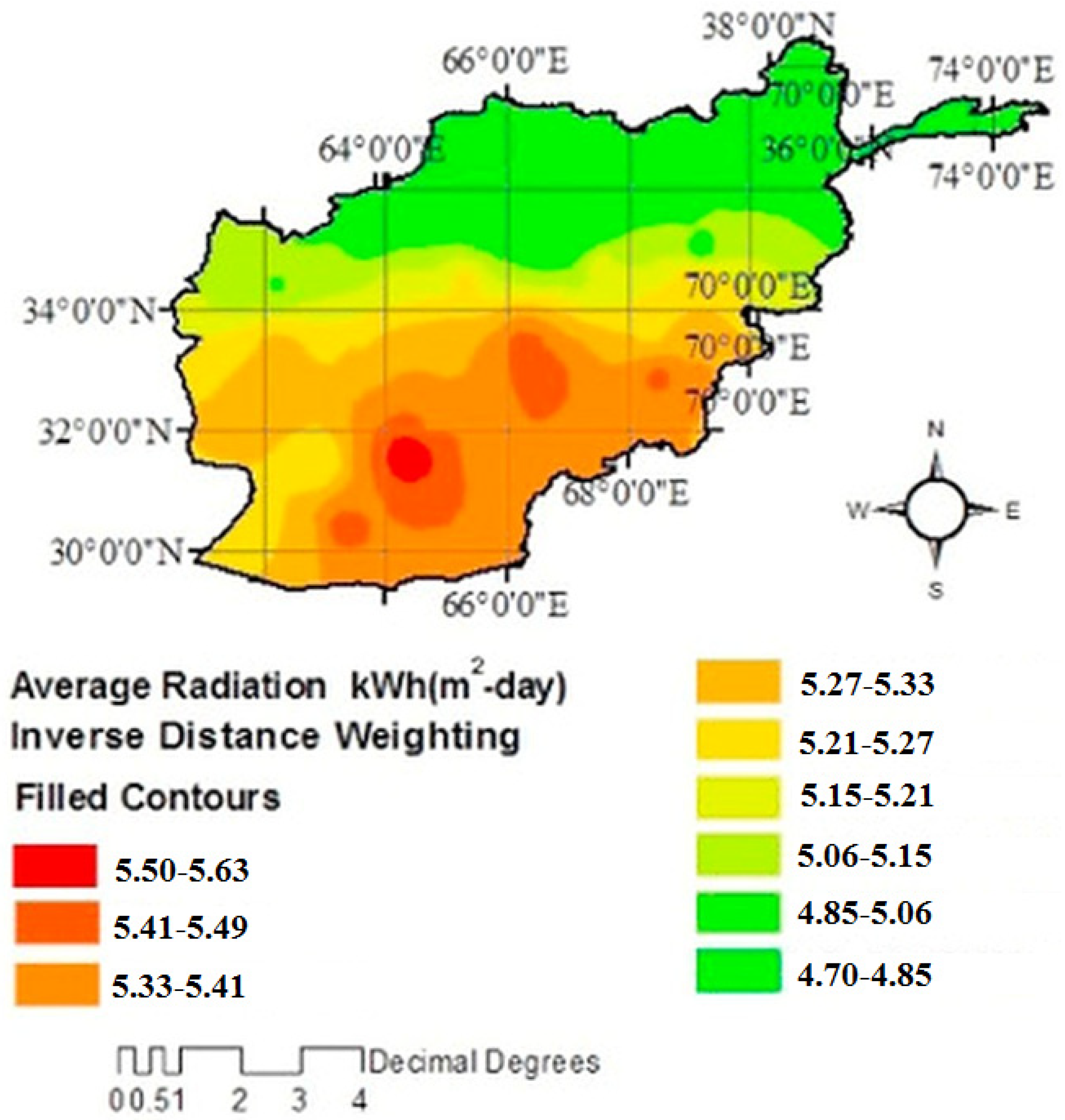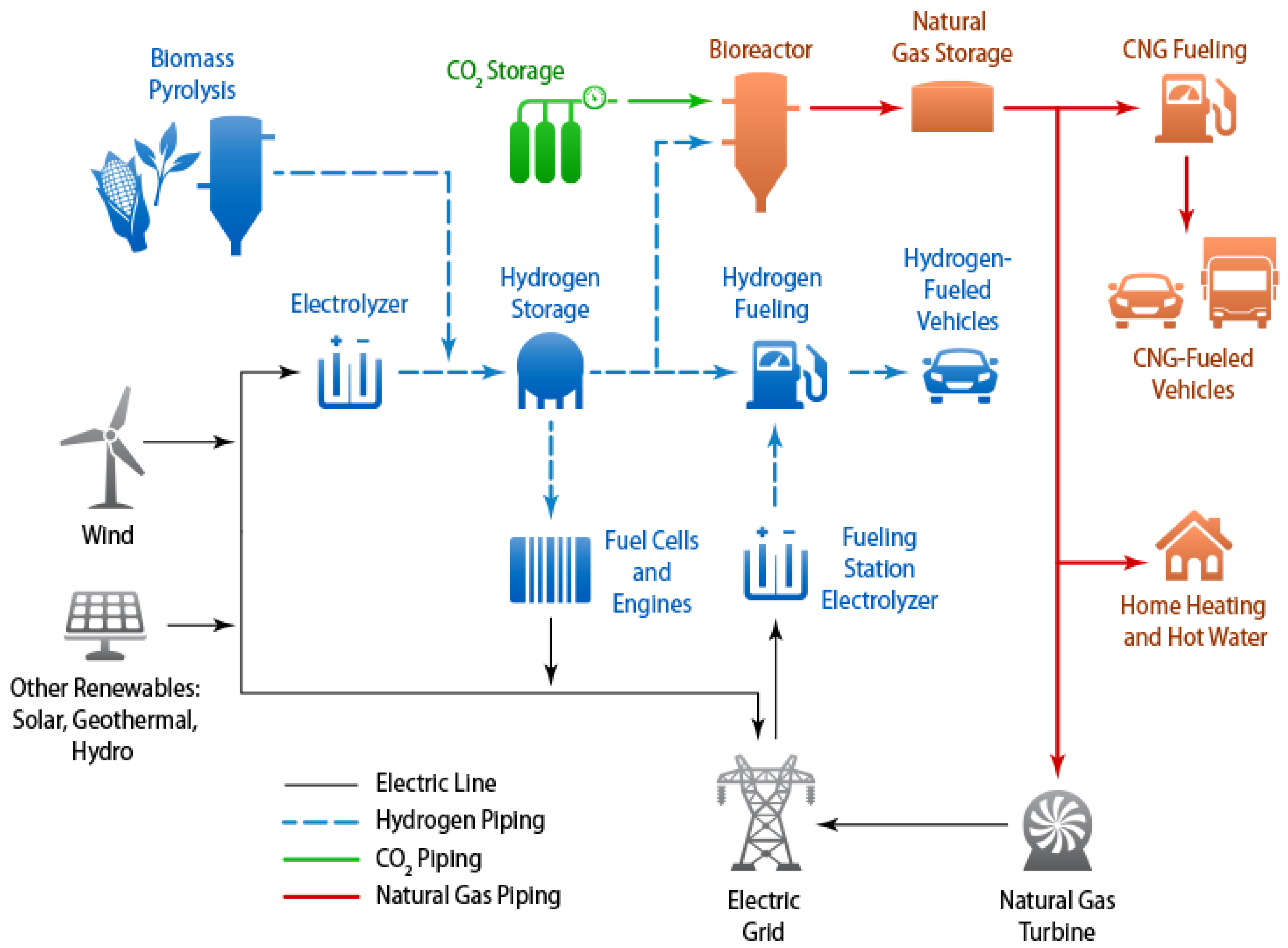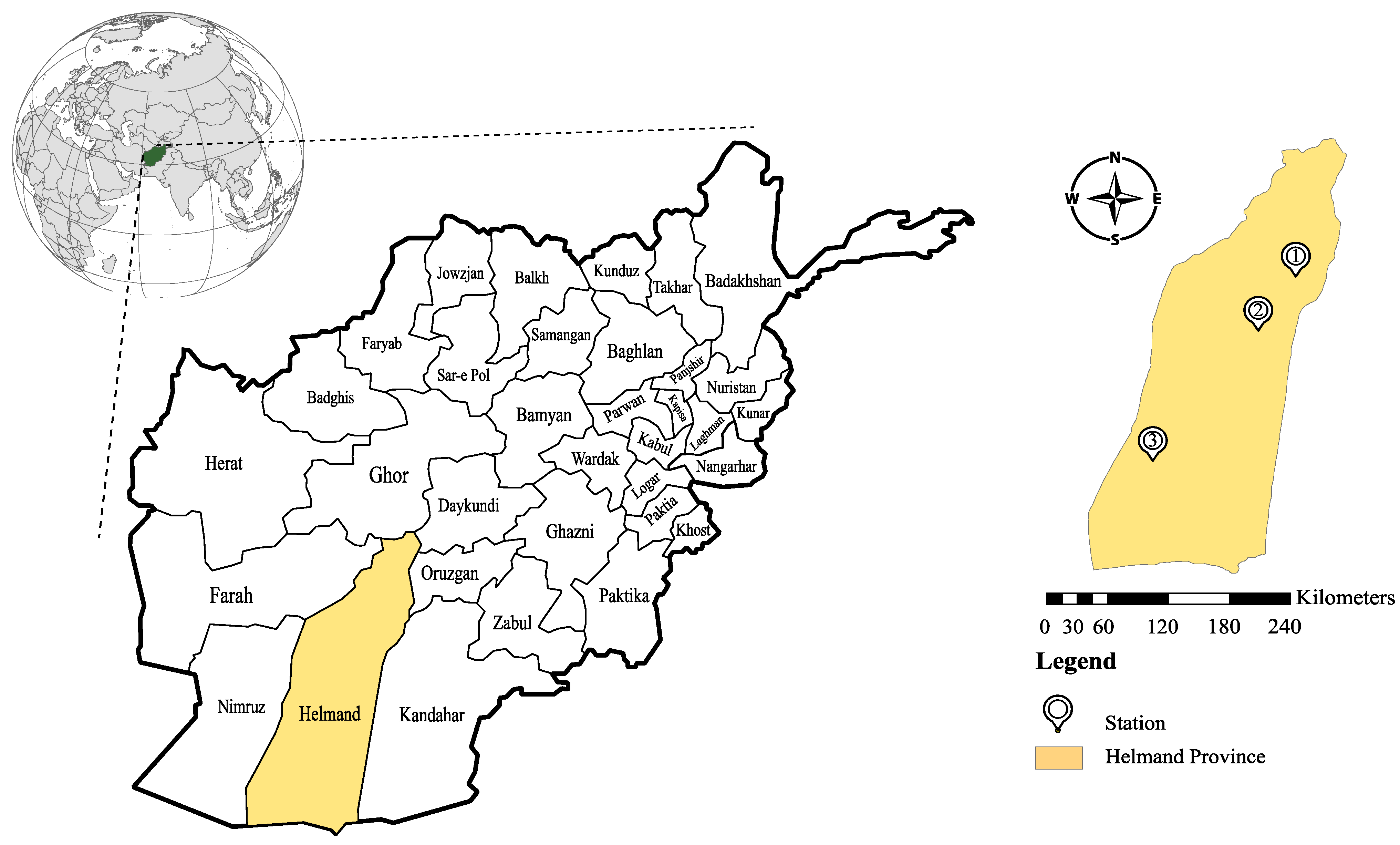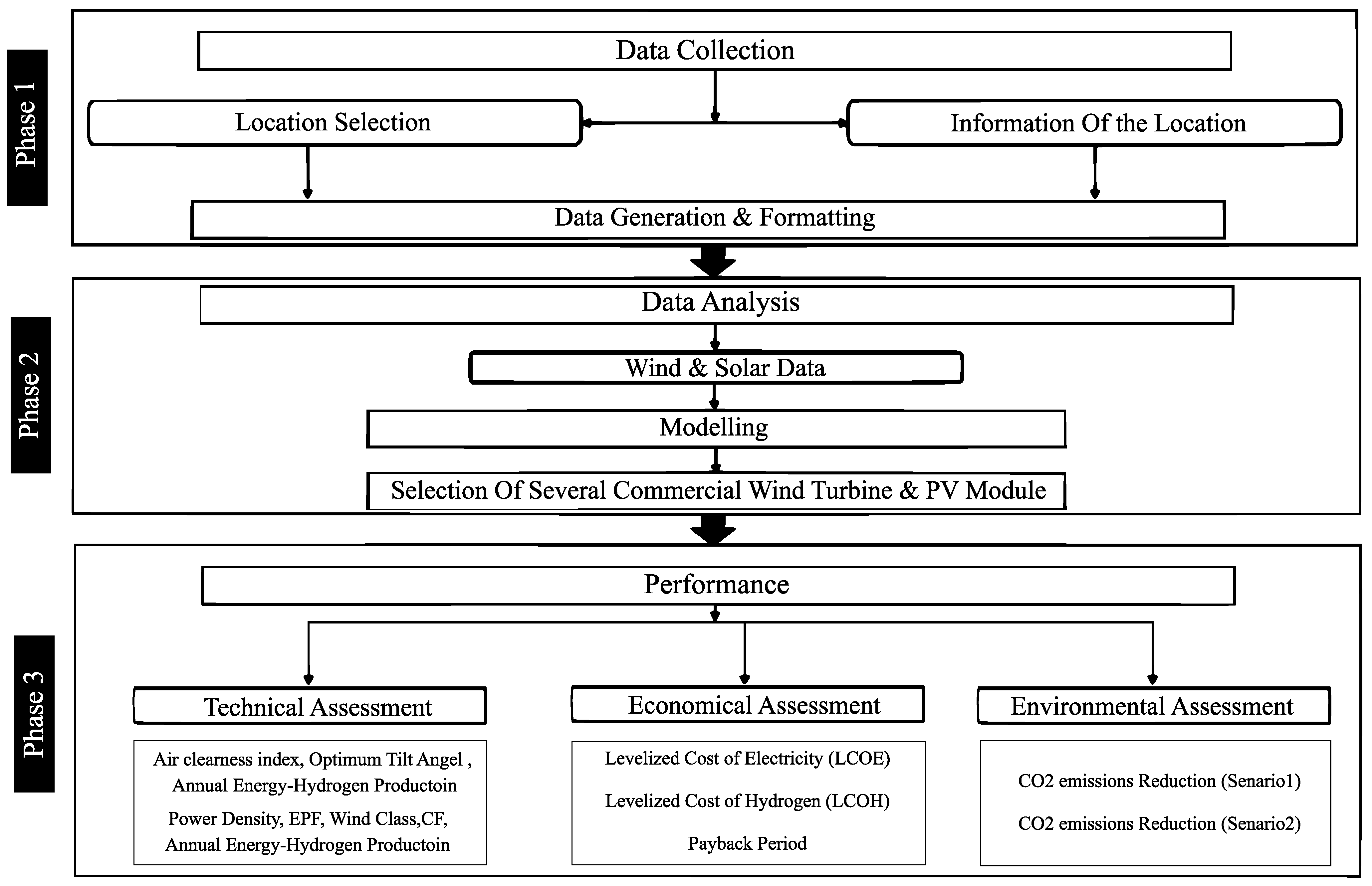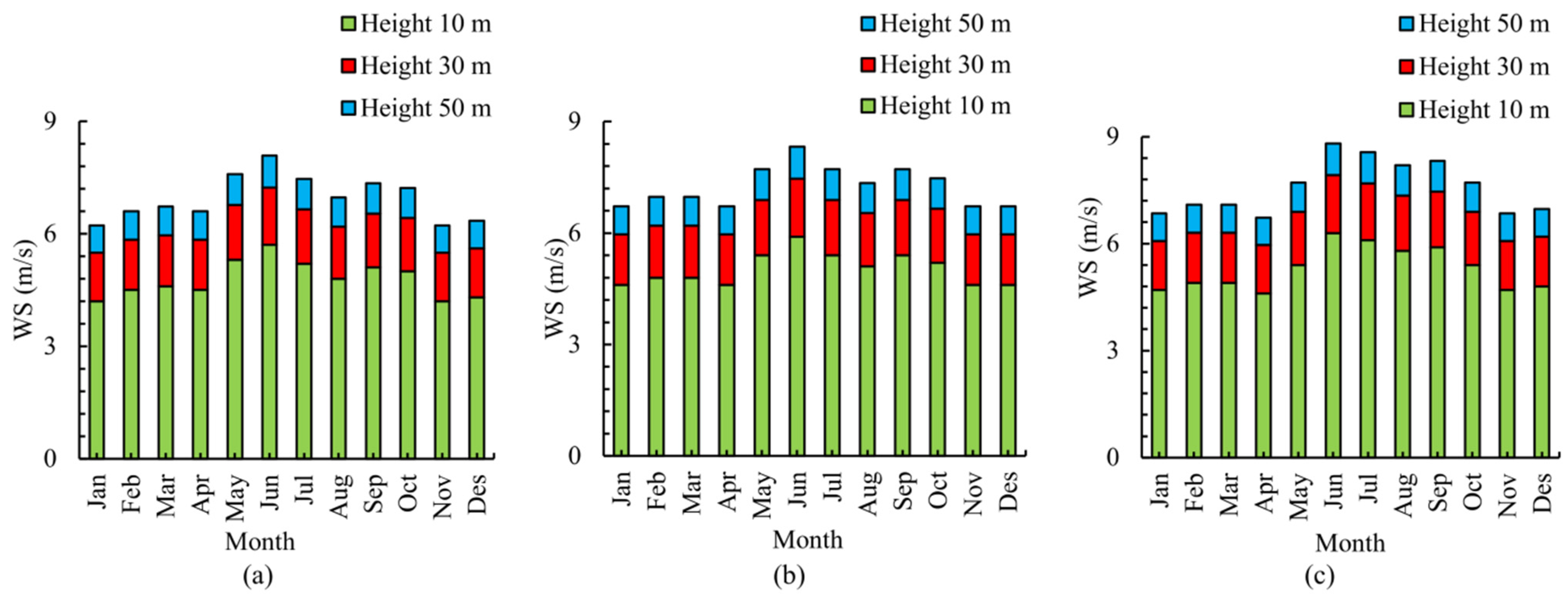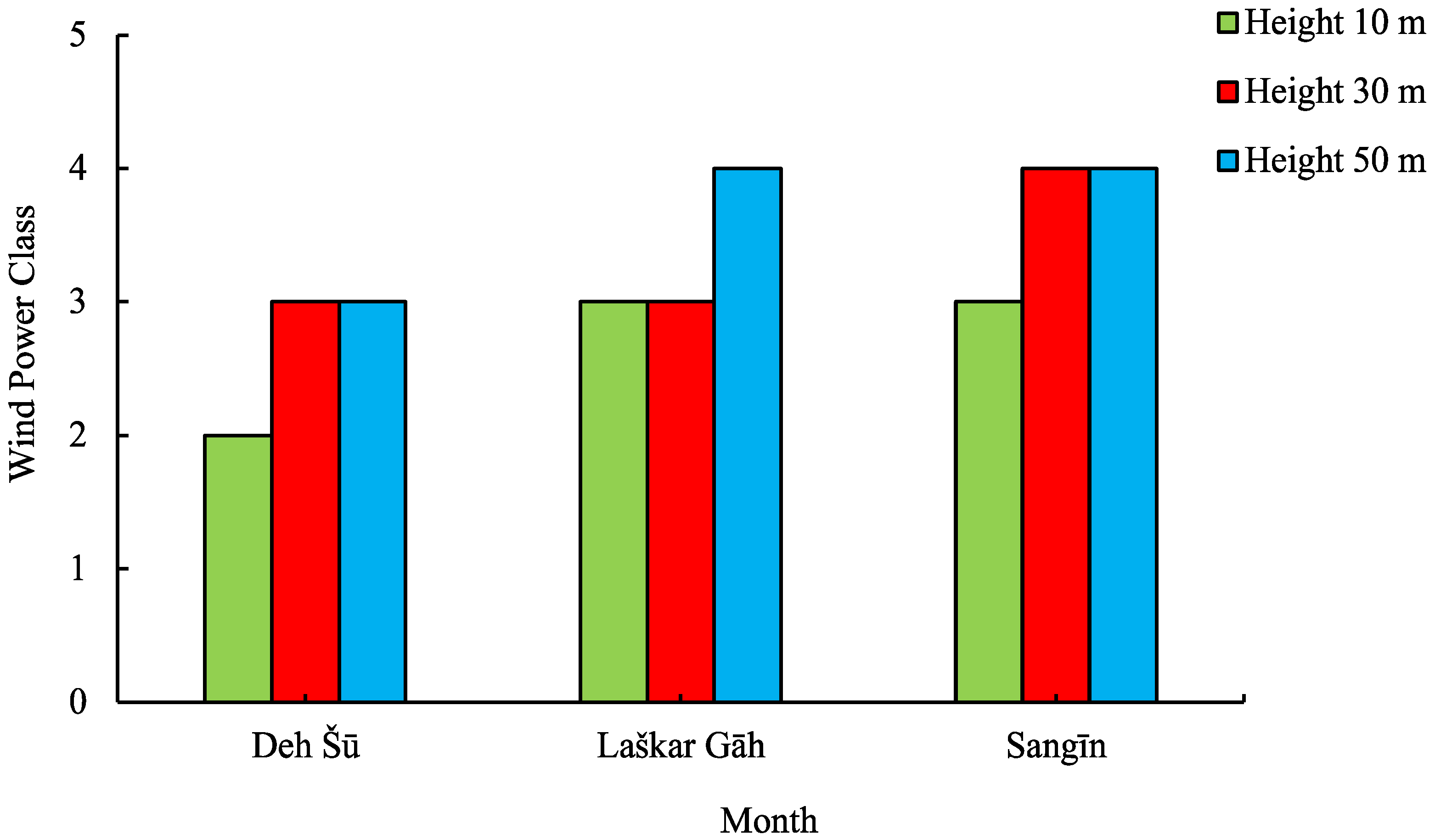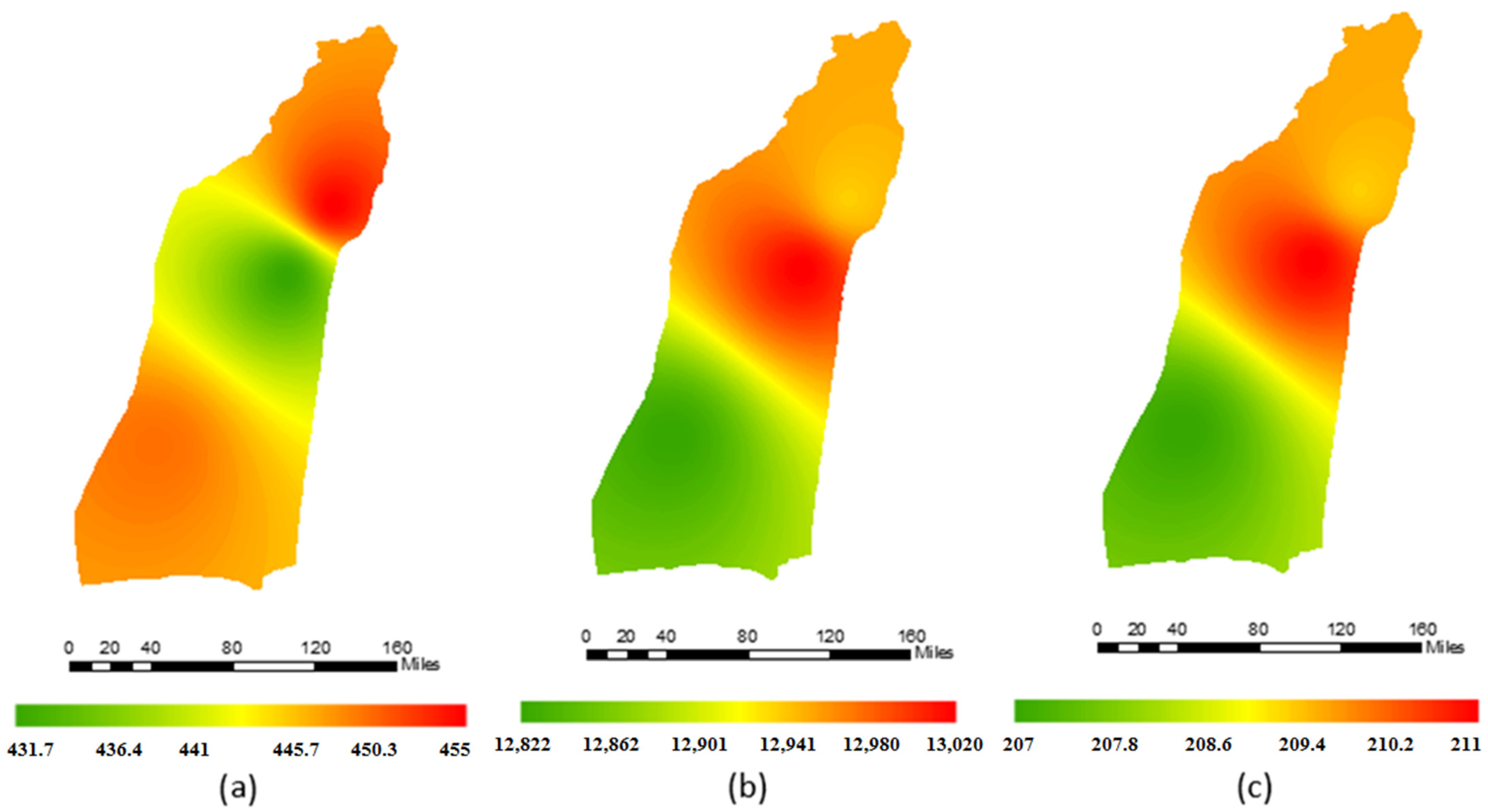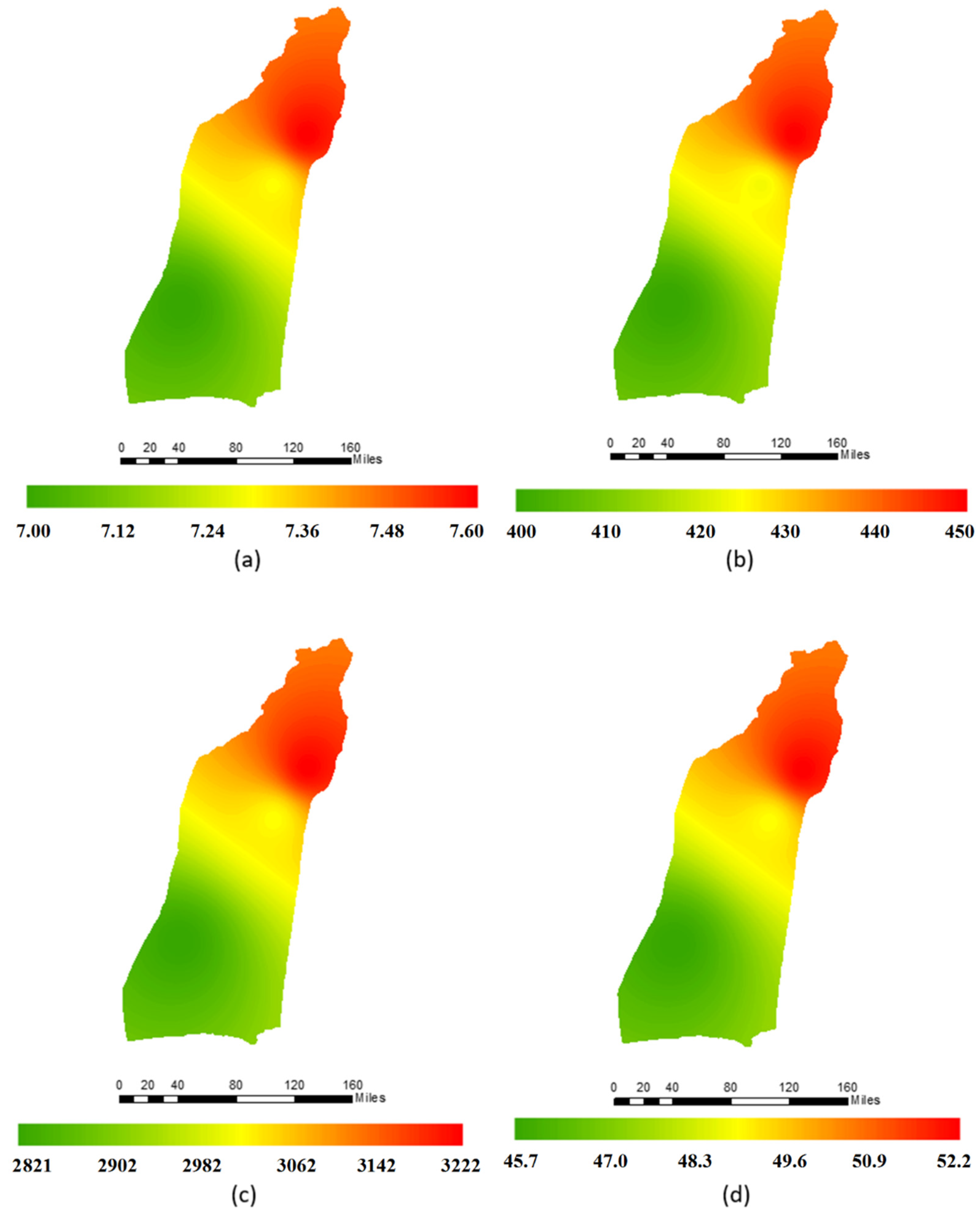1. Introduction
Energy appears to be playing a crucial role in the economic development of nations. However, the overutilization of fossil fuel sources to satisfy ever-growing energy demand has created a range of environmental problems—most notably, global warming and climate change due to greenhouse gas emissions. In response, most countries have adopted some measures to prevent or at least minimize such environmental impacts. At present, the transition from fossil fuels to clean energies is at the top of the agenda in many countries.
Given the non-renewable nature of fossil fuel reserves and their extensive environmental impacts, many governments have adopted energy policies focused on the widespread use of renewable energies and the promotion of the renewable energy industry [
1,
2]. Kaygusuz [
3] reported that without such energy policies, roughly 1.2 billion people worldwide will not be able to gain access to electricity by 2030. This is an especially important issue in Afghanistan, where energy is in high demand, but there are many infrastructural challenges in meeting this demand. Statistics published by the Afghan government show that only 10–15% of the Afghan population has permanent access to electricity, which is one of the lowest rates in the world [
4,
5]. This rate is much lower in rural areas. Afghanistan is a war-devastated country with grave political and social stability problems, with a population of mostly young people and children, a majority of which live in rural areas. Unfortunately, many rural communities of this country suffer from technological, social, and economic underdevelopment [
6]. According to Afghanistan’s power sector master plan, the net energy demand in Afghanistan is expected to increase sixfold by 2032 [
4]. Certainly, Afghanistan’s current electricity generation system will not be able to keep up with this demand. Given the vital importance of access to electricity for social and economic development, fossil fuel sources are likely to play a major role in meeting global power demand for the foreseeable future, but renewable energies are also turning into viable alternatives for power generation [
7].
Afghanistan has extensive wind energy capacity, especially in its western regions, where some areas experience strong winds on about 120 days per year. According to an assessment conducted by the American National Renewable Energy Laboratory (NREL), a 31,611 km
2 area in this region has wind speeds above Class 4 (wind speeds above 6.8 m/s and wind power densities above 400 W/m
2). According to this assessment, if one 5 MW turbine is installed in each 1 km
2 area of the region, it will have a wind capacity of 158.1 GW [
8].
Figure 1 shows the wind energy distribution in Afghanistan. As is known, the highest wind speeds are in the northeastern and western parts of the country. However, wind speeds are also high in the southern parts of the country. In fact, in the southern part of the country and especially in the Helmand province, the average wind speed is more than 5 m/s, and there is high potential for wind energy in this region.
Afghanistan also has an average of 300 sunny days a year, many of which have intense sunshine and cloudless skies. The average annual normal irradiation in Afghanistan is over 1022 kWh/m
2. In the southern and western parts of the country, this figure reaches 1825–2445 kWh/m
2. Solar energy is abundantly available in all parts of Afghanistan. According to NREL’s map of Afghanistan’s solar resources, the average annual global horizontal irradiation of the country is in the range of 3.9–5.9 kWh/m
2 per day, which is suitable for installing solar photovoltaic (PV) panels [
8]. The installed PV capacity in various places in the world is shown in
Figure 2. As the figure shows, despite having extensive solar capacity, the greater Middle East region has lower installed PV capacity than other parts of the world.
Figure 2 also shows the potential for solar energy in Afghanistan. As is known, the highest solar radiation is in the southern regions of this country and, especially, in the Helmand province of Afghanistan. The solar radiation in this area is more than 5.5 kWh/m
2/day.
Hydrogen is a highly potent energy source that can serve as a substitute for hydrocarbon fuels in road and sea transport, heating, and other applications [
10]. While being highly flammable, which poses some problems in storage and transport, hydrogen offers an energy density of about 120–142 megajoules per kilogram, which is almost three times higher than that of oil [
11]. In addition, burning hydrogen produces water rather than greenhouse gases, which is a massive environmental advantage [
12]. Furthermore, because of its electrochemical properties, hydrogen can be used in fuel cells and carried in liquid and gaseous forms, as well as metal hydrides [
13].
Figure 3 depicts many approaches for generating power and hydrogen from renewable sources.
One of the important tasks to perform before starting any project or business is to conduct a feasibility study to see if investing resources in the concept is financially viable [
15,
16,
17]. The main goal of this study is to assess the viability of generating power from renewable wind and solar energy and then to investigate the production of clean hydrogen fuel from various technical, economic, and environmental perspectives in the Helmand province of Afghanistan.
The present study contributes to the literature in several ways. Most importantly, this is the first economic and environmental feasibility study of renewable power and hydrogen production in any part of Afghanistan. In addition, this is the first time that the 20-year averages of wind speed and solar radiation records are used to examine the renewable energy potentials of the area of interest to help Afghan energy policymakers weigh their options with regard to investment in renewable energy sources. The paper also provides a series of GIS maps, which can facilitate the site location of renewable energy projects.
2. Review of Literature
Rising concerns about the environmental impacts of fossil fuels have created a strong impetus for transition to cleaner energy sources and, specifically, renewable energies, such as wind and solar, which are widely available all over the world and can serve as sustainable energy sources without the disadvantages of fossil fuels. Recent years have also seen a growing interest in the use of hydrogen as a clean substitution for fossil fuels. Traditionally, hydrogen is mostly used in the production of ammonia, methanol, and other chemical compounds, as well as in soil enrichment, but it has a promising future as a clean energy carrier.
In recent decades, many studies have investigated the viability of wind power generation projects in different parts of the world. For example, Mostafaeipour et al. [
18] investigated the viability of generating wind power in Binalood, Iran. Wind speed data from a station at Binalood were used to assess wind power at three heights of 10, 30, and 40 m in this study. This study reported that the density of wind power in the studied area was 305,514 W/m
2 at a height of 40 m, which provides an excellent possibility for producing power from wind energy. In another study, Using the Weibull function, the economic and technical feasibility of generating electricity from renewable wind energy in Shahr-e Babak in Iran was evaluated by Mostafaeipour et al. [
19]. After analyzing the wind data of a station in the area, they reported that the wind power of the area is weak and could be better harvested with small wind projects. They identified a 10 kw wind turbine as the best choice for the area and conducted an economic assessment accordingly. The results showed that the cost of electricity produced by such a project would be 0.18
$/kWh. Hulio et al. [
20] assessed the viability of wind power production in Hawke’s Bay, Pakistan. This assessment was carried out using data collected from a single station at three heights of 30, 60, and 80 m for five wind turbines ranging in size from 1650 to 2750 kW and with hub heights ranging from 80 to 103.6 m. This study’s techno-economic analyses revealed that the best wind power density is 307.5 W/m
2 at a height of 80 m, based on which the minimum cost of electricity generation by the considered wind turbines would be 0.056
$/kWh. Alkhalidi et al. [
21] presented a technical examination of offshore wind energy generation in Kuwait in their study. For this purpose, they used the wind data of 10 stations to estimate wind energy at four altitudes of 50, 80, 100, and 120 m. Baseer et al. [
22] performed a technical assessment of wind power generation in the industrial city of Jubail in Saudi Arabia. The assessment was done using wind data from nine stations at three different heights of 10, 50, and 90 m and with five wind turbines with nominal powers ranging from 1800 to 3300 kW and hub heights ranging from 75 to 119 m. In this study, the highest wind power density was 168.46 W/m
2 at a height of 90 m, and the highest wind turbine capacity factor was 25%. Arslan [
23] analyzed the environmental, economic, and technical feasibility of generating power from wind energy in Kutahya, Turkey. This examination was done based on the wind data of one station in the area for six types of wind turbines with nominal powers of 200–1500 kW. Bahrami et al. [
24] assessed the economic and technical viability of generating power from wind energy in Uzbekistan. After a technical evaluation of 17 different sites, they reported that only four of these sites were eligible for economic evaluations. Mostafaeipour et al. [
25] studied the viability of electricity production from wind energy in South Africa. It was reported that wind power generation at Port Elizabeth will have the lowest LCOE, and the minimum cost of generated power will be 0.363
$/kWh if EOLO wind turbines are used.
Many studies have also investigated the feasibility of solar power generation in different parts of the world. In Iran, Firouzjah [
26] assessed the economic and technical viability of solar power generation in 15 cities using solar panels with fixed tilt angles and capacities of 1, 5, and 10 kWh. This assessment showed that solar power generation is more economically feasible in the southern parts of Iran. In a technical assessment of solar energy in Pakistan, Tahir and Asim [
27] estimated the average annual global horizontal irradiance of the whole country to be 5.30 kWh/m
2 a day. In a feasibility study of solar energy in Saudi Arabia, Almasoud and Gandayh [
28] reported that the power generated by solar energy in this country can cost less than the electricity generated by fossil fuels if one factors in the medical costs arising from air pollution. In a technical–economic–environmental assessment of PV systems in Kuwait, Ramadhan and Naseeb [
29] used the data of one station to examine and compare the feasibility of four PV plants with capacities of 1 to 100 MW. Their results showed that in the case of using the 1 MW system, the cost of electricity will be 0.2
$/kWh. Altarawneh et al. [
30] conducted a technical assessment to estimate the potential of generating power from solar energy in the Ma’an region of Jordan. This study’s findings revealed that the average global irradiance in this region is 6.5 kWh/m
2, and that to reach proper efficiency, the angle of PV panels should be changed four times a year. In a study by Anwarzai and Nagasaka [
4], the GIS method was used to undertake a technical analysis of solar and wind energy in Afghanistan. These researchers also used the SAM (System Advisor Model) to determine the preferred CSP technologies based on annual power output. Nematollahi and Kim [
31] assessed the potential for solar power generation in South Korea and produced a series of GIS maps for annual horizontal irradiance and sunshine hours in this country.
Many believe that hydrogen can serve as an ideal carrier for the energy produced from various renewable sources, such as solar and wind, without CO
2 emissions [
32,
33]. The conversion of renewable power into hydrogen turns the haphazardly available renewable energy into a stable environmentally friendly fuel that can be consumed anytime and anywhere. Many investigations have been done on the generation of hydrogen from renewable energy sources, particularly solar and wind. In one of these studies, in four places in Iran’s Fars province, Mostafaeipour et al. [
34] discussed the feasibility of generating hydrogen from wind energy. This study revealed that among the four selected locations, the best one is Abadeh (with an average annual density of 220 W/m
2), where a 900 kW wind turbine can generate the power needed to produce hydrogen fuel for 22 small vehicles. Nematollahi et al. [
35] made an economic and technical assessment for producing hydrogen from solar energy in Iran’s Sistan and Baluchestan provinces. They reported that a 900 kW turbine built in this area can generate power for producing 39.2 tons of hydrogen a year. Al-Sharafi et al. [
36] studied the possibilities for hydrogen generation in the Dhahran, Riyadh, Jeddah, Abha, and Yanbu regions of Saudi Arabia using wind and solar energy. They estimated the unit cost of hydrogen production in these areas to be
$1.43 per kilogram. In a study by Iqbal et al. [
37], they evaluated the potential for wind-powered hydrogen production in eight sites located in the Sindh province of Pakistan. The economic assessments of this study were performed with the assumption of using a 2500 kW turbine. This study reported that using wind power, Pakistan can produce 51,917 tons of hydrogen per day. Jahangiri et al. [
38] evaluated the environmental, economic, and technical viability of electricity generation and hydrogen production from solar/wind sources in Qatar. In a study by Mostafaeipour et al. [
6] on geothermal-powered hydrogen production in Afghanistan, they identified 17 locations in Afghanistan that are suitable for this purpose.
Despite the multitude of studies on the feasibility of wind and solar power generation around the world, including the neighbors of Afghanistan (
Table 1), unfortunately, no study has been conducted on the feasibility of common renewable sources within this country. As the above literature review shows, so far, no study has been conducted on the environmental and economic feasibility of renewable energy for producing hydrogen and power in any part of Afghanistan. This paper aims to address this gap in the literature by presenting a technical, environmental, and economic feasibility evaluation of the production of power and hydrogen from solar and wind energy in the Helmand province of Afghanistan.
6. Conclusions
This research is a comprehensive study that includes comprehensive analyses, such as an environmental analysis and economic and technical analyses of renewable energy sources for generating power and hydrogen in the Helmand province of Afghanistan. First, the feasibility of solar and wind energy sources in three stations located in this province was investigated; then, GIS maps of each energy source were prepared and the suitable areas for building wind or solar power plants were determined. For all stations, an economic assessment was also performed for a range of wind turbines and PV panels. The results show that the production of power and hydrogen from wind and solar energy in the province is economically viable. In addition to being economically justified, implementing such projects in the region will have significant environmental benefits. This study can serve as a roadmap for building hydrogen production plants powered by wind power stations (wind hydrogen), solar power stations (solar hydrogen), or a combination of both (solar–wind hydrogen) in the Helmand area. The hybrid SWARA–WASPAS MCDM method was used to evaluate the choice of a suitable location for the construction of wind/solar power plants from different perspectives. A summary of the most important results of this study is provided below:
The optimal tilt angle of PV panels (to maximize power and hydrogen output) in the study area was 30 degrees (
Figure 7).
With a power output of 1302 MWh and a hydrogen output of 21.08 tons a year, solar energy generation with 600 kW modules in the study area will be technically and economically justified (
Table 8).
The price of renewable power generated in this area will be 0.0648
$/kWh, which is twice as cheap as the official tariff of renewable power in Afghanistan. The payback period of these projects will be about 6 years, which reflects its economic feasibility (
Table 9).
The region has significant wind energy potential, which can be exploited to produce 3222.2 MWh of wind power and 52.158 tons of hydrogen per year (
Table 15).
Wind power generation in the region is also economically justifiable, as the price of generated electricity will be 0.0573
$/kWh and the payback period of the projects will be between 3 and 13 years (
Table 16).
The prepared GIS maps showed that the most appropriate place for building a power plant driven by wind energy is the northern part of the province, but the most suitable place for building a solar power plant is the central part of the province (
Figure 10 and
Figure 11).
The results of SWARA evaluation showed that the economic criterion was the most important criterion, and the environmental criterion was the least important criterion (
Table 17).
The WASPAS results showed that Sangīn is the most suitable place for the construction of a wind hydrogen power plant and Laškar Gāh is the most suitable place for the construction of a solar hydrogen power plant (
Table 18).
Despite the potential and benefits of renewable energy development in West Asia, and especially in Afghanistan, there are obstacles both nationally and regionally. The most important obstacles to the development of renewable energy in Afghanistan are fossil fuel subsidies, lack of a feed-in tariff structure, lack of incentive for private-sector participation, weak environmental laws, low priority of renewable energy in national planning, and a weak executive framework. One of the solutions is energy planning based on technical–economic evaluations, which was analyzed in the present study. Another practical policy for attracting investors is the mandatory connection and purchase policy. Eliminating fossil fuel subsidies and creating a national development fund for renewable energy is another practical policy.

